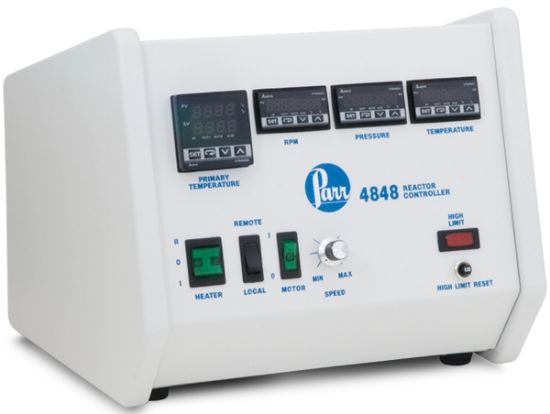230 VAC Electrical Supply Model
The Parr 4843 and 4836 Controllers have been replaced with the new 4848 Controller. This new controller brings digital communications to all of the functions of these modular reactor controllers.
The 4848 Controller continues to offer all of the features previously included in the 4843 Controller; namely:
- PID control
- Ramp and soak programming
- Separate heating and cooling control loops
- Motor speed control
- Full or half power heater option
- Lockout relay and reset for over temperature protection
- Expansion modules for tachometer, pressure, and high temperature alarm
- Auto tuning of PID parameters
In recent versions of the 4843 and 4836 Controllers, the primary controller was equipped with an RS232C digital communications port and software for two-way communications with a PC. The expansion modules for stirrer speed display, vessel pressure readout, high temperature protection, and motor current readout could be ordered with analog outputs that required an analog to digital conversion board to log these readings into a PC.
With the 4848 Controller, all of the expansion modules as well as the primary temperature controller are equipped with bidirectional digital communications [RS-485] that enable the user to not only log all current reading to a PC, but also to send set points, stirrer speeds, and alarm values from the PC to the 4848 Controller.
Modular Design
A total of seven different modules are offered for the 4848 Controller. A maximum of three expansion modules in addition to the primary temperature control can be installed in the 4848 Controller. The user can select either the Tachometer Display Module or the Motor Control Module. This either/ or option also applies to the High Temperature Cut Off and External Temperature Limit Modules.
1. Temperature Control Module (TCM)
The temperature control module can accept either thermocouples or RTD temperature sensors. It has three outputs that are used for heating and cooling control and for alarm actuated heater cut off. The control function is a full proportional, integral and derivative (PID) control with auto-tune capabilities.
The controller provides ramp and soak programming with up to 64 segments.
The temperature in the reactor is transmitted to and displayed on the PC on a continual basis.
Screenshot from remote PC showing Set Point and Process values for up to four variables. Lower section showing operating parameters of active module.
2. Pressure Display Module (PDM)
The pressure monitoring module is set up to accept its input from a pressure transducer mounted on the reactor or attached accessory. It can be set to accept a wide variety of operating ranges. Operating pressures are transmitted continuously to the PC. These modules are available calibrated in either psi or bar. In most applications, pressures are controlled by either a forward or back pressure regulator. The output from the pressure monitoring module is connected to the alarm relay to shut off power to the heater if the high pressure limit set by the operator is reached during operation.
3A. Tachometer Display Module (TDM)
In this configuration, the module will display the stirrer speed and will continuously transmit it to the PC for display and logging. The stirrer speed is set manually using a potentiometer on the face of the 4848 Controller.
3B. Motor Control Module (MCM)
In this configuration, the module provides true closed loop feedback control of the reactor stirring speed. The primary output of this module is wired to dynamically adjust the motor voltage in response to changes in motor loading. This provides better reactor stirring speed regulation than the standard open loop speed control, especially with reactions that involve changing viscosities. Additionally, the use of this module allows the stirring speed set point to be adjusted remotely from the host PC. A byproduct of this closed loop speed control scheme is that the value of the primary controller output directly reflects the degree of loading on the motor in order to maintain a constant stirring speed. While not a direct torque measurement, this is a useful option for those who want to, for example, monitor the progress of polymerisation reactions in which there is a change in viscosity as the reaction proceeds. The output to the motor can be displayed on the PC, but to log this value requires the addition of the Motor Torque Module.
4A. High Temperature Cut Off Module (HTM)
The high temperature cut off module or limit controller augments the operation of the main control module. Its redundant sensor can be mounted either internally or externally to the reactor. The primary output of the module is wired to activate the lock out relay in order to provide safety shutdown should the reactor reach an unsafe temperature.
4B. External Temperature Limit Module (ETLM)
This configuration uses the same aforementioned HTM Module with its sensor mounted in such a way to monitor the reactor’s outside wall temperature. The primary output of this module is used to limit the external temperature of the reactor. This is done by interrupting the control signal form the main temperature controller when the ext

